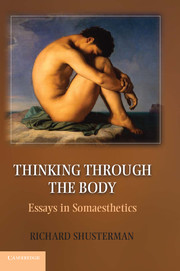Book contents
- Frontmatter
- Contents
- Preface
- Introduction
- Part I Somatic Being, Knowing, and Teaching
- 1 Thinking through the Body
- 2 The Body as Background
- 3 Self-Knowledge and Its Discontents
- 4 Muscle Memory and the Somaesthetic Pathologies of Everyday Life
- 5 Somaesthetics in the Philosophy Classroom
- Part II Somaesthetics, Aesthetics, and Culture
- Part III The Arts and the Art of Living
- Select Bibliography
- Index
- References
5 - Somaesthetics in the Philosophy Classroom
A Practical Approach
Published online by Cambridge University Press: 05 November 2012
- Frontmatter
- Contents
- Preface
- Introduction
- Part I Somatic Being, Knowing, and Teaching
- 1 Thinking through the Body
- 2 The Body as Background
- 3 Self-Knowledge and Its Discontents
- 4 Muscle Memory and the Somaesthetic Pathologies of Everyday Life
- 5 Somaesthetics in the Philosophy Classroom
- Part II Somaesthetics, Aesthetics, and Culture
- Part III The Arts and the Art of Living
- Select Bibliography
- Index
- References
Summary
I
“Please take off your shoes and lie down on your back. Keep your legs long, lengthened, if that is not uncomfortable. But if it is, just put something under the backs of your knees or lie with your knees bent and your soles on the floor. Close your eyes so that you can concentrate on feeling your body, and notice that you don't really need to see your legs (or to remember what they looked like) in order to know that your legs are long or instead bent sharply at the knee. We can sense this directly through proprioception (our inner bodily sense) and our tactile sense of the body's contact with the floor. What we're going to do in this lesson is to come to know ourselves better somatically by examining how our body feels through such proprioception and bodily tactile feeling. We're going to do it in an organized way that will take about ten minutes, proceeding systematically from one body area to another, comparing and contrasting felt positions, angles, weights, volumes, etc.
“In following my instructions and my questions – for example, about which side, arm, leg, shoulder (left or right) feels heavier or lighter – you should not worry about the responses of others; just answer on the basis of your own experience and to yourself – do not answer aloud, so as not to interfere with the experience and replies of others. Different people have different bodies and different habits of bodily posture and use, and those differences will be reflected in their experience of self-examination in this supine position. Always make sure you're breathing comfortably, lying comfortably, and are not straining. If you feel you are getting sore or stiff, find a more comfortable position. The purpose of this lesson is not to embarrass, shock, provoke, or give you the giggles, but to instruct you in a method that can contribute to the realization of one of philosophy's central goals – that of self-knowledge; here, somatic self-knowledge. Philosophy has traditionally linked its central goal of self-knowledge with the goal of self-cultivation or self-care, on the grounds that we can care for something better if we know more about it; that to effectively cultivate or improve the self and its behavior we need to know those aspects of the self and behavior we wish to improve or cultivate; here, our somatic selves. So please relax with your eyes closed (eyes probably tired from too much reading or video viewing), and follow my instructions.…”
- Type
- Chapter
- Information
- Thinking through the BodyEssays in Somaesthetics, pp. 112 - 122Publisher: Cambridge University PressPrint publication year: 2012
References
- 1
- Cited by



